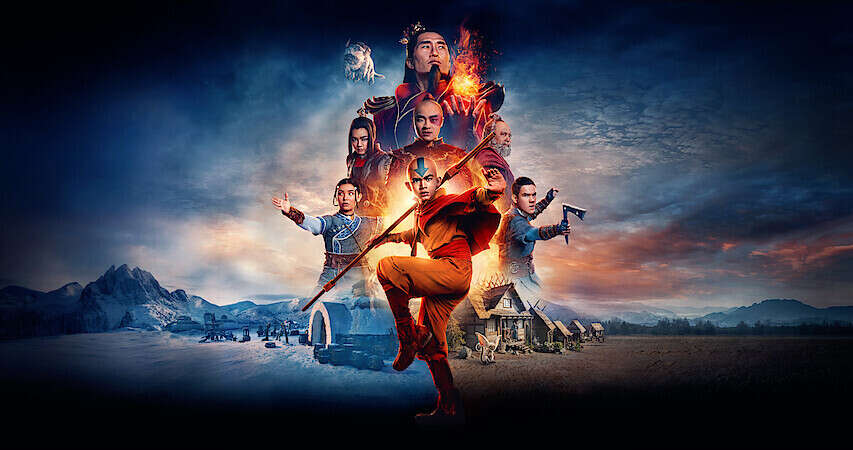Restoring Balance: A Review of Netflix’s Avatar Adaptation
Netflix’s new live-action adaptation of Avatar: The Last Airbender is inevitably compared to its predecessors, the beloved animated series and the disappointing M. Night Shyamalan film. Can this new adaptation overcome the pitfalls of the past, especially with its reliance on child actors? How can it meet the high expectations set by the original cartoon that has garnered a dedicated fanbase?
Surprisingly, Netflix’s Avatar manages to delight viewers by striking a careful balance between the expansive world of the animated series and the shortcomings of the movie adaptation. While it may not replace the original series in fans’ hearts, it remains sincere, respectful of the source material, and introduces enough new elements to stand on its own.
Exploring the World of Avatar
For the uninitiated, Avatar: The Last Airbender unfolds in a fantasy realm inspired by diverse Asian cultures, featuring four distinct nation-states: the Fire Nation, Water Tribes, Earth Kingdom, and Air Nomads. Each nation possesses unique traditions and abilities, with some individuals capable of bending elements like water, fire, earth, and air to their will. The Avatar, the sole being able to bend all four elements, plays a crucial role in maintaining balance among the nations.
As the Fire Nation launches a war of conquest, the Avatar disappears for a century, allowing conflict to ravage the world across generations.
While the lore of Avatar may seem overwhelming at first, Netflix’s adaptation struggles with an information overload in its initial episode. The exposition-heavy dialogue can feel clunky, especially for the young cast members. Additionally, the show’s early emphasis on weighty themes may give off a darker tone than intended. However, once past these initial hurdles, the series gains momentum.
The story centers on Aang, a young Airbender discovered frozen in ice by siblings Sokka and Katara from the Southern Water Tribe. Together, they form Team Avatar and face relentless pursuit by Zuko, a prince from the Fire Nation.
This live-action adaptation of Avatar caters more to a young adult or teen audience compared to the original animated series. While it features increased violence, including intense scenes, the depiction remains relatively restrained. Fans may be surprised to hear characters like Sokka using slightly stronger language, but it aligns with the adaptation’s portrayal of his character.
![]()
Restoring Balance: A Review of Avatar: The Last Airbender
One of the central themes in Avatar: The Last Airbender revolves around the immense pressure that Aang, the young Avatar, must bear. This mirrors the weight placed on the shoulders of the talented child actor, Gordon Cormier, who portrays Aang. Despite a few instances of flat delivery in the initial episode, Cormier rises admirably to the challenge, infusing his performance with vitality, playfulness, and genuine optimism.
Similarly, Kiawentiio Tarbell shines in her role as Katara, injecting the character with a vibrant big-sister energy that elevates her beyond a mere voice of reason. Ian Ousley’s portrayal of Sokka stands out, capturing Sokka’s blend of overconfidence, goofiness, sweetness, and vulnerability with finesse.
The Depth of Antagonists
The antagonists in the series bring a richness to their performances that is equally compelling. Daniel Dae Kim’s portrayal of Firelord Ozai is chilling, despite some distracting chin hair, depicting him as a ruthless ruler who manipulates his children to fulfill his ambitions. Dallas Liu’s Zuko strikes a delicate balance between a formidable adversary consumed by anger and a vulnerable young man striving to meet his father’s expectations.
However, the standout performance comes from Paul Sun-Hyung Lee as Iroh, Zuko’s uncle. Lee’s portrayal breathes new life into the beloved character, endearing him to the audience once again.
Exploring the Fire Nation
This adaptation delves deeper into the inner workings of the Fire Nation, particularly through the character of Princess Azula, played by Elizabeth Yu. By providing more screen time for Azula early on, the series offers a more nuanced portrayal of her character, highlighting her rivalry with Zuko and her strategic maneuvers. The addition of a secret alliance between Azula and Lieutenant Zhao adds a layer of palace intrigue that enriches the narrative.
It is the actors themselves who truly shine in this live-action adaptation, bringing a new dimension to the characters through their expressions and body language. The interactions between characters like Iroh and Zuko or Aang and Monk Gyatso are imbued with emotional depth and complexity.
Enhanced Storytelling
While slightly condensed compared to the animated original, the adaptation weaves familiar elements together in unexpected ways, creating a cohesive and engaging narrative. The season maintains a continuous flow, avoiding episodic detours and introducing new layers to the characters’ backgrounds.
Notably, the adaptation excels in capturing the dynamic energy of the fight scenes, a hallmark of the series. The choreography of the bending forms is executed with precision, blending martial arts movements seamlessly with elemental manipulation.
Embracing the Heart of the Series
Despite some melodramatic moments, the adaptation stays true to the heart of Avatar: The Last Airbender, exploring themes of patriarchy, generational trauma, pacifism, and the power of connections. The finale delivers a satisfying resolution while setting the stage for future developments, capturing the essence of the beloved series.
For more information, please visit our site 60time.com, and don’t forget to follow us on social media at Facebook.



